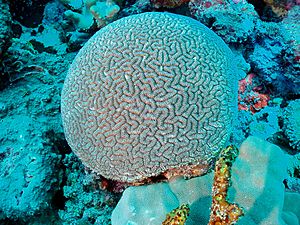Ctenella facts for kids
Quick facts for kids Ctenella |
|
|---|---|
 |
|
| Ctenella chagius | |
| Conservation status | |
| Scientific classification |
Ctenella is a special type of stony coral. There is only one known species in this group, called Ctenella chagius. These corals are very large and have wavy patterns on their surface, like a brain. They have strong, solid walls and fine, neat ridges inside. You can find them only in the Indian Ocean, specifically around the Chagos Archipelago. They grow into smooth, round shapes, like big domes.
Contents
What Does Ctenella chagius Look Like?
Ctenella chagius is a huge, dome-shaped colony of corals. Its surface has many cracks and looks a bit like a brain. Each tiny coral animal, called a polyp, builds a hard, stony cup. These cups are called corallites. They are arranged in long, winding rows, forming valleys.
Coral Structure and Size
The solid ridges on either side of these valleys are about 1.5 centimetres (0.6 inches) wide. The valleys themselves are about 1 centimetre (0.4 inches) deep. Fine, thin walls called septa spread out from the corallites. These septa are packed closely and are spaced evenly. Some of them even go up and over the ridges.
Color and Symbiotic Algae
This coral is usually a pale brown color. It can grow to be as big as one metre (about 3 feet) across! Ctenella chagius is a zooxanthellate coral. This means it has tiny, plant-like organisms called dinoflagellates living inside its tissues. These tiny organisms are a type of algae. They have a special symbiotic relationship with the coral. The algae make food using sunlight, and the coral uses this food to grow.
Where Does Ctenella chagius Live?
Ctenella chagius is found only around the Chagos Islands. These islands are located in the Indian Ocean. You can find this coral in calm, shallow areas called lagoons. It also lives on the sides of coral reefs, which are called reef slopes. It can be found at depths of up to 45 metres (about 148 feet) underwater.
Why Is Ctenella chagius Endangered?
Ctenella chagius is in serious trouble. It is listed as "critically endangered" on the IUCN Red List of Threatened Species. This means it faces a very high risk of disappearing forever. We don't know exactly how many of these corals are left. However, the coral reefs where they live are getting damaged very quickly. This happens faster than the corals can grow new colonies.
Threats to the Coral
This coral is very sensitive to coral bleaching. Coral bleaching happens when corals get stressed, often from warmer ocean temperatures. They lose their colorful algae and turn white. If the stress continues, the coral can die. Ctenella chagius is also easily affected by coral diseases. Both bleaching and diseases are becoming more common as sea temperatures rise around the world.
Protection Efforts
Human activities also threaten this coral. However, the Chagos Islands are now part of the Chagos Marine Protected Area. This protected area helps to keep the ocean environment safe. It should offer some protection for Ctenella chagius and other marine life.


